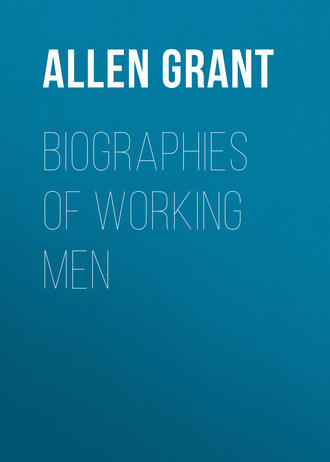 полная версия
полная версияBiographies of Working Men
Telford had now come to be regarded as the great practical authority upon all that concerned roads or communications; and he was reaping the due money-reward of his diligence and skill. Every day he was called upon to design new bridges and other important structures in all parts of the kingdom, but more especially in Scotland and on the Welsh border. Many of the most picturesque bridges in Britain, which every tourist has admired, often without inquiring or thinking of the hand that planned them, were designed by his inventive brain. The exquisite stone arch which links the two banks of the lesser Scotch Dee in its gorge at Tongueland is one of the most picturesque; for Telford was a bit of an artist at heart, and, unlike too many modern railway constructors, he always endeavoured to make his bridges and aqueducts beautify rather than spoil the scenery in whose midst they stood. Especially was he called in to lay out the great system of roads by which the Scotch Highlands, then so lately reclaimed from a state of comparative barbarism, were laid open for the great development they have since undergone. In the earlier part of the century, it is true, a few central highways had been run through the very heart of that great solid block of mountains; but these were purely military roads, to enable the king's soldiers more easily to march against the revolted clans, and they had hardly more connection with the life of the country than the bare military posts, like Fort William and Fort Augustus, which guarded their ends, had to do with the ordinary life of a commercial town. Meanwhile, however, the Highlands had begun gradually to settle down; and Telford's roads were intended for the far higher and better purpose of opening out the interior of northern Scotland to the humanizing influences of trade and industry.
Fully to describe the great work which the mature engineer constructed in the Highland region, would take up more space than could be allotted to such a subject anywhere save in a complete industrial history of roads and travelling in modern Britain. It must suffice to say that when Telford took the matter in hand, the vast block of country north and west of the Great Glen of Caledonia (which divides the Highlands in two between Inverness and Ben Nevis)—a block comprising the counties of Caithness, Sutherland, Ross, Cromarty, and half Inverness—had literally nothing within it worthy of being called a road. Wheeled carts or carriages were almost unknown, and all burdens were conveyed on pack-horses, or, worse still, on the broad backs of Highland lassies. The people lived in small scattered villages, and communications from one to another were well-nigh impossible. Telford set to work to give the country, not a road or two, but a main system of roads. First, he bridged the broad river Tay at Dunkeld, so as to allow of a direct route straight into the very jaws of the Highlands. Then, he also bridged over the Beauly at Inverness, so as to connect the opposite sides of the Great Glen with one another. Next, he laid out a number of trunk lines, running through the country on both banks, to the very north of Caithness, and the very west of the Isle of Skye. Whoever to this day travels on the main thoroughfares in the greater Scottish Islands—in Arran, Islay, Jura, Mull; or in the wild peninsula of Morvern, and the Land of Lorne; or through the rugged regions of Inverness-shire and Ross-shire, where the railway has not yet penetrated,—travels throughout on Telford's roads. The number of large bridges and other great engineering masterpieces on this network of roads is enormous; among the most famous and the most beautiful, are the exquisite single arch which spans the Spey just beside the lofty rearing rocks of Craig Ellachie, and the bridge across the Dee, beneath the purple heather-clad braes of Ballater. Altogether, on Telford's Highland roads alone, there are no fewer than twelve hundred bridges.
Nor were these the only important labours by which Telford ministered to the comfort and well-being of his Scotch fellow-countrymen. Scotland's debt to the Eskdale stonemason is indeed deep and lasting. While on land, he improved her communications by his great lines of roads, which did on a smaller scale for the Highland valleys what railways have since done for the whole of the civilized world; he also laboured to improve her means of transit at sea by constructing a series of harbours along that bare and inhospitable eastern coast, once almost a desert, but now teeming with great towns and prosperous industries. It was Telford who formed the harbour of Wick, which has since grown from a miserable fishing village into a large town, the capital of the North Sea herring fisheries. It was he who enlarged the petty port of Peterhead into the chief station of the flourishing whaling trade. It was he who secured prosperity for Fraserburgh, and Banff, and many other less important centres; while even Dundee and Aberdeen, the chief commercial cities of the east coast, owe to him a large part of their present extraordinary wealth and industry. When one thinks how large a number of human beings have been benefited by Telford's Scotch harbour works alone, it is impossible not to envy a great engineer his almost unlimited power of permanent usefulness to unborn thousands of his fellow-creatures.
As a canal-maker, Telford was hardly less successful than as a constructor of roads and harbours. It is true, his greatest work in this direction was in one sense a failure. He was employed by Government for many years as the engineer of the Caledonian Canal, which runs up the Great Glen of Caledonia, connecting the line of lakes whose basins occupy that deep hollow in the Highland ranges, and so avoiding the difficult and dangerous sea voyage round the stormy northern capes of Caithness. Unfortunately, though the canal as an engineering work proved to be of the most successful character, it has never succeeded as a commercial undertaking. It was built just at the exact moment when steamboats were on the point of revolutionizing ocean traffic; and so, though in itself a magnificent and lordly undertaking, it failed to satisfy the sanguine hopes of its projectors. But though Telford felt most bitterly the unavoidable ill success of this great scheme, he might well have comforted himself by the good results of his canal-building elsewhere. He went to Sweden to lay out the Gotha Canal, which still forms the main high-road of commerce between Stockholm and the sea; while in England itself some of his works in this direction—such as the improvements on the Birmingham Canal, with its immense tunnel—may fairly be considered as the direct precursors of the great railway efforts of the succeeding generation.
The most remarkable of all Telford's designs, however, and the one which most immediately paved the way for the railway system, was his magnificent Holyhead Road. This wonderful highway he carried through the very midst of the Welsh mountains, at a comparatively level height for its whole distance, in order to form a main road from London to Ireland. On this road occurs Telford's masterpiece of engineering, the Menai suspension bridge, long regarded as one of the wonders of the world, and still one of the most beautiful suspension bridges in all Europe. Hardly less admirable, however, in its own way is the other suspension bridge which he erected at Conway, to carry his road across the mouth of the estuary, beside the grey old castle, with which its charming design harmonizes so well. Even now it is impossible to drive or walk along this famous and picturesque highway without being struck at every turn by the splendid engineering triumphs which it displays throughout its entire length. The contrast, indeed, between the noble grandeur of Telford's bridges, and the works on the neighbouring railways, is by no means flattering in every respect to our too exclusively practical modern civilization.
Telford was now growing an old man. The Menai bridge was begun in 1819 and finished in 1826, when he was sixty-eight years of age; and though he still continued to practise his profession, and to design many valuable bridges, drainage cuts, and other small jobs, that great undertaking was the last masterpiece of his long and useful life. His later days were passed in deserved honour and comparative opulence; for though never an avaricious man, and always anxious to rate his services at their lowest worth, he had gathered together a considerable fortune by the way, almost without seeking it. To the last, his happy cheerful disposition enabled him to go on labouring at the numerous schemes by which he hoped to benefit the world of workers; and so much cheerfulness was surely well earned by a man who could himself look back upon so good a record of work done for the welfare of humanity. At last, on the 2nd of September, 1834, his quiet and valuable life came gently to a close, in the seventy-eighth year of his age. He was buried in Westminster Abbey, and few of the men who sleep within that great national temple more richly deserve the honour than the Westerkirk shepherd-boy. For Thomas Telford's life was not merely one of worldly success; it was still more pre-eminently one of noble ends and public usefulness. Many working men have raised themselves by their own exertions to a position of wealth and dignity far surpassing his; few indeed have conferred so many benefits upon untold thousands of their fellow-men. It is impossible, even now, to travel in any part of England, Wales, or Scotland, without coming across innumerable memorials of Telford's great and useful life; impossible to read the full record of his labours without finding that numberless structures we have long admired for their beauty or utility, owe their origin to the honourable, upright, hardworking, thoroughgoing, journeyman mason of the quiet little Eskdale village. Whether we go into the drained fens of Lincolnshire, or traverse the broad roads of the rugged Snowdon region; whether we turn to St. Katharine's Docks in London, or to the wide quays of Dundee and those of Aberdeen; whether we sail beneath the Menai suspension bridge at Bangor, or drive over the lofty arches that rise sheer from the precipitous river gorge at Cartland, we meet everywhere the lasting traces of that inventive and ingenious brain. And yet, what lad could ever have started in the world under apparently more hopeless circumstances than widow Janet Telford's penniless orphan shepherd-boy Tam, in the bleakest and most remote of all the lonely border valleys of southern Scotland?
II
GEORGE STEPHENSON, ENGINE-MAN
Any time about the year 1786, a stranger in the streets of the grimy colliery village of Wylam, near Newcastle, might have passed by without notice a ragged, barefooted, chubby child of five years old, Geordie Stephenson by name, playing merrily in the gutter and looking to the outward eye in no way different from any of the other colliers' children who loitered about him. Nevertheless, that ragged boy was yet destined in after-life to alter the whole face of England and the world by those wonderful railways, which he more than any other man was instrumental in first constructing; and the story of his life may rank perhaps as one of the most marvellous in the whole marvellous history of able and successful British working men.
George Stephenson was born in June, 1781, the son of a fireman who tended the pumping engine of the neighbouring colliery, and one of a penniless family of six children. So poor was his father, indeed, that the whole household lived in a single room, with bare floor and mud wall; and little Geordie grew up in his own unkempt fashion without any schooling whatever, not even knowing A from B when he was a big lad of seventeen. At an age when he ought to have been learning his letters, he was bird's-nesting in the fields or running errands to the Wylam shops; and as soon as he was old enough to earn a few pence by light work, he was set to tend cows at the magnificent wages of twopence a day, in the village of Dewley Burn, close by, to which his father had then removed. It might have seemed at first as though the future railway engineer was going to settle down quietly to the useful but uneventful life of an agricultural labourer; for from tending cows he proceeded in due time (with a splendid advance of twopence) to leading the horses at the plough, spudding thistles, and hoeing turnips on his employer's farm. But the native bent of a powerful mind usually shows itself very early; and even during the days when Geordie was still stumbling across the freshly ploughed clods or driving the cows to pasture with a bunch of hazel twigs, his taste for mechanics already made itself felt in a very marked and practical fashion. During all his leisure time, the future engineer and his chum Bill Thirlwall occupied themselves with making clay models of engines, and fitting up a winding machine with corks and twine like those which lifted the colliery baskets. Though Geordie Stephenson didn't go to school at the village teacher's, he was teaching himself in his own way by close observation and keen comprehension of all the machines and engines he could come across.
Naturally, to such a boy, the great ambition of his life was to be released from the hoeing and spudding, and set to work at his father's colliery. Great was Geordie's joy, therefore, when at last he was taken on there in the capacity of a coal-picker, to clear the loads from stones and rubbish. It wasn't a very dignified position, to be sure, but it was the first step that led the way to the construction of the Liverpool and Manchester Railway. Geordie was now fairly free from the uncongenial drudgery of farm life, and able to follow his own inclinations in the direction of mechanical labour. Besides, was he not earning the grand sum of sixpence a day as picker, increased to eightpence a little later on, when he rose to the more responsible and serious work of driving the gin-horse? A proud day indeed it was for him when, at fourteen, he was finally permitted to aid his father in firing the colliery engine; though he was still such a very small boy that he used to run away and hide when the owner went his rounds of inspection, for fear he should be thought too little to earn his untold wealth of a shilling a day in such a grown-up occupation. Humbler beginnings were never any man's who lived to become the honoured guest, not of kings and princes only, but of the truly greatest and noblest in the land.
A coal-miner's life is often a very shifting one; for the coal in particular collieries gets worked out from time to time; and he has to remove, accordingly, to fresh quarters, wherever employment happens to be found. This was very much the case with George Stephenson and his family; all of them being obliged to remove several times over during his childish days in search of new openings. Shortly after Geordie had attained to the responsible position of assistant fireman, his father was compelled, by the closing of Dewley Burn mine, to get a fresh situation hard by at Newburn. George accompanied him, and found employment as full fireman at a small working, whose little engine he undertook to manage in partnership with a mate, each of them tending the fire night and day by twelve-hour shifts. Two years later, his wages were raised to twelve shillings a week, a sure mark of his diligent and honest work; so that George was not far wrong in remarking to a fellow-workman at the time that he now considered himself a made man for life.
During all this time, George Stephenson never for a moment ceased to study and endeavour to understand the working of every part in the engine that he tended. He was not satisfied, as too many workmen are, with merely learning the routine work of his own trade; with merely knowing that he must turn such and such a tap or valve in order to produce such and such a desired result: he wanted to see for himself how and why the engine did this or that, what was the use and object of piston and cylinder and crank and joint and condenser—in short, fully to understand the underlying principle of its construction. He took it to pieces for cleaning whenever it was needful; he made working models of it after his old childish pattern; he even ventured to tinker it up when out of order on his own responsibility. Thus he learnt at last something of the theory of the steam-engine, and learnt also by the way a great deal about the general principles of mechanical science. Still, even now, incredible as it seems, the future father of railways couldn't yet read; and he found this terrible drawback told fatally against his further progress. Whenever he wanted to learn something that he didn't quite understand, he was always referred for information to a Book. Oh, those books; those mysterious, unattainable, incomprehensible books; how they must have bothered and worried poor intelligent and aspiring but still painfully ignorant young George Stephenson! Though he was already trying singularly valuable experiments in his own way, he hadn't yet even begun to learn his letters.
Under these circumstances, George Stephenson, eager and anxious for further knowledge, took a really heroic resolution. He wasn't ashamed to go to school. Though now a full workman on his own account, about eighteen years old, he began to attend the night school at the neighbouring village of Walbottle, where he took lessons in reading three evenings every week. It is a great thing when a man is not ashamed to learn. Many men are; they consider themselves so immensely wise that they look upon it as an impertinence in anybody to try to tell them anything they don't know already. Truly wise or truly great men—men with the capability in them for doing anything worthy in their generation—never feel this false and foolish shame. They know that most other people know some things in some directions which they do not, and they are glad to be instructed in them whenever opportunity offers. This wisdom George Stephenson possessed in sufficient degree to make him feel more ashamed of his ignorance than of the steps necessary in order to conquer it. Being a diligent and willing scholar, he soon learnt to read, and by the time he was nineteen he had learnt how to write also. At arithmetic, a science closely allied to his native mechanical bent, he was particularly apt, and beat all the other scholars at the village night school. This resolute effort at education was the real turning-point in George Stephenson's remarkable career, the first step on the ladder whose topmost rung led him so high that he himself must almost have felt giddy at the unwonted elevation.
Shortly after, young Stephenson gained yet another promotion in being raised to the rank of brakesman, whose duty it was to slacken the engine when the full baskets of coal reached the top of the shaft. This was a more serious and responsible post than any he had yet filled, and one for which only the best and steadiest workmen were ever selected. His wages now amounted to a pound a week, a very large sum in those days for a skilled working-man.
Meanwhile, George, like most other young men, had fallen in love. His sweetheart, Fanny Henderson, was servant at the small farmhouse where he had taken lodgings since leaving his father's home; and though but little is known about her (for she unhappily died before George had begun to rise to fame and fortune), what little we do know seems to show that she was in every respect a fitting wife for the active young brakesman, and a fitting mother for his equally celebrated son, Robert Stephenson. Fired by the honourable desire to marry Fanny, with a proper regard for prudence, George set himself to work to learn cobbling in his spare moments; and so successfully did he cobble the worn shoes of his fellow-colliers after working hours, that before long he contrived to save a whole guinea out of his humble earnings. That guinea was the first step towards an enormous fortune; a fortune, too, all accumulated by steady toil and constant useful labour for the ultimate benefit of his fellow-men. To make a fortune is the smallest and least noble of all possible personal ambitions; but to save the first guinea which leads us on at last to independence and modest comfort is indeed an important turning-point in every prudent man's career. Geordie Stephenson was so justly proud of his achievement in this respect that he told a friend in confidence he might now consider himself a rich man.
By the time George was twenty-one, he had saved up enough by constant care to feel that he might safely embark on the sea of housekeeping. He was able to take a small cottage lodging for himself and Fanny, at Willington Quay, near his work at the moment, and to furnish it with the simple comfort which was all that their existing needs demanded. He married Fanny on the 28th of November, 1802; and the young couple proceeded at once to their new home. Here George laboured harder than ever, as became the head of a family. He was no more ashamed of odd jobs than he had been of learning the alphabet. He worked overtime at emptying ballast from ships; he continued to cobble, to cut lasts, and even to try his hand at regular shoemaking; furthermore, he actually acquired the art of mending clocks, a matter which lay strictly in his own line, and he thus earned a tidy penny at odd hours by doctoring all the rusty or wheezy old timepieces of all his neighbours. Nor did he neglect his mechanical education meanwhile; for he was always at work upon various devices for inventing a perpetual motion machine. Now perpetual motion is the most foolish will-o'-the-wisp that ever engaged a sane man's attention: the thing has been proved to be impossible from every conceivable point of view, and the attempt to achieve it, if pursued to the last point, can only end in disappointment if not in ruin. Still, for all that, the work George Stephenson spent upon this unpractical object did really help to give him an insight into mechanical science which proved very useful to him at a later date. He didn't discover perpetual motion, but he did invent at last the real means for making the locomotive engine a practical power in the matter of travelling.
A year later, George's only son Robert was born; and from that moment the history of those two able and useful lives is almost inseparable. During the whole of George Stephenson's long upward struggle, and during the hard battle he had afterwards to fight on behalf of his grand design of railways, he met with truer sympathy, appreciation, and comfort from his brave and gifted son than from any other person whatsoever. Unhappily, his pleasure and delight in the up-bringing of his boy was soon to be clouded for a while by the one great bereavement of an otherwise singularly placid and happy existence. Some two years after her marriage, Fanny Stephenson died, as yet a mere girl, leaving her lonely husband to take care of their baby boy alone and unaided. Grief for this irretrievable loss drove the young widower away for a while from his accustomed field of work among the Tyneside coal-pits; he accepted an invitation to go to Montrose in Scotland, to overlook the working of a large engine in some important spinning-works. He remained in this situation for one year only; but during that time he managed to give clear evidence of his native mechanical insight by curing a defect in the pumps which supplied water to his engine, and which had hitherto defied the best endeavours of the local engineers. The young father was not unmindful, either, of his duty to his boy, whom he had left behind with his grandfather on Tyneside; for he saved so large a sum as L28 during his engagement, which he carried back with him in his pocket on his return to England.
A sad disappointment awaited him when at last he arrived at home. Old Robert Stephenson, the father, had met with an accident during George's absence which made him quite blind, and incapacitated him for further work. Helpless and poor, he had no resource to save him from the workhouse except George; but George acted towards him exactly as all men who have in them a possibility of any good thing always do act under similar circumstances. He spent L15 of his hard-earned savings to pay the debts the poor blind old engine-man had necessarily contracted during his absence, and he took a comfortable cottage for his father and mother at Killingworth, where he had worked before his removal to Scotland, and where he now once more obtained employment, still as a brakesman. In that cottage this good and brave son supported his aged parents till their death, in all the simple luxury that his small means would then permit him.











